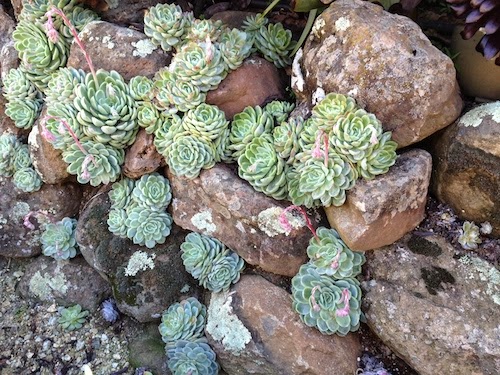 |
| Dudleya pulverulenta is a gorgeous California native |
The severe drought of the last three years has demanded a revised approach to gardening and garden design in California. If you haven't replaced your lawn yet, consider taking advantage of incentives and rebates. Check your local city web pages.
Dialing it up a Notch
Having a landscape with low to moderate water needs in a severe drought isn't good enough, so I've been dialing up the drought tolerance of my garden. Besides, the less I'm watering other stuff, the more edibles I can grow.
And it's not that I'll be deprived of a rewarding garden, it just takes some focused plant choices. To keep it simple, collecting plants from the salvia (sages) and succulents groups offers lots of showy and water-wise choices, including drought tolerant California natives. As a bonus, saliva and succulent flowers are potent magnets for pollinators, especially hummingbirds and bees of various types.
A Sage for Every Garden
 |
| Pineapple Sage, Salvia elegans, is a hummingbird magnet |
 |
| Many sages flower almost all year round |
If you are choosing sages at your local nursery, make sure to check on the water needs of each specific variety before you plant them in your garden. They'll reward you with abundant flowers and fragrant foliage with very little upkeep. Most sages appreciate an annual pruning to renew foliage and flowers for the next season.
Succulent Envy
 |
| A recent shopping trip to Succulent Gardens in Castroville |



Great article on water wise plants and focusing on Succulents and Salvias. Saving water for edibles :)
ReplyDeleteThank you for your kind comment- we really have to do all we can!
Deletecheers,
Patricia
Nice succulents
ReplyDeleteThanks! Succulents seem to be endless in the varieties available and so photogenic :)
ReplyDeleteThis comment has been removed by the author.
ReplyDeleteLovely succulents! I have few kinds in pots and want to move them into the garden outside, but how can I propagate them form my old plants? Are there any seeds, or do I have to cut any parts of the plant?Thank you for the nice post!
ReplyDeleteHi Jacquie, sorry it's taken me awhile to respond! In general, succulents are easy to propagate and grow if you follow a couple of rules: good drainage is a must, so if you transfer any to your garden, make sure they will not sit in soggy soil. You can amend the planting area with lava fines, for example, (fertilizer is not necessary). And remember that they like to dry out before being watered again, and that not all like full hot sun.
ReplyDeleteSucculents are most easily propagated by cutting the "pups" (the babies that form) cleanly, leaving a short stem. Let these cuttings sit in a dry place out of sun for a few days till the cut side is dry, then stick into soil that is slightly damp. They will begin to root. You can also just set them on top of a tray of dry perlite or potting soil until they start putting out tiny roots- then plant them.
For a great book, see "Succulents Simplified" (Timber Press) by Debra Lee Baldwin.
Thanks for writing! Have fun,
Patricia
This comment has been removed by a blog administrator.
ReplyDelete